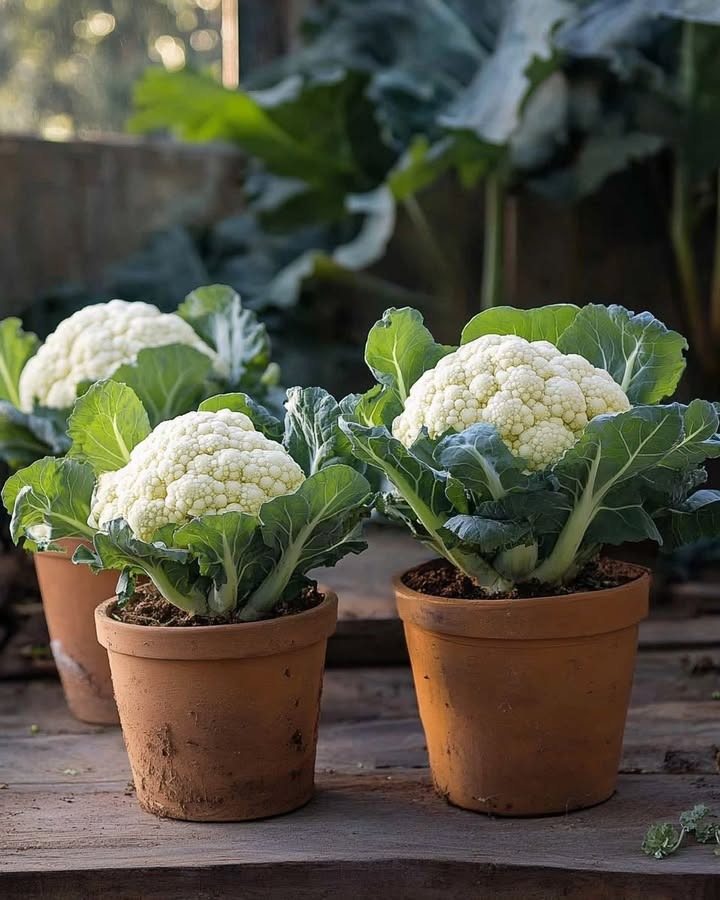Ensure the plant had full growing time (don’t rush).
Ensure roots were not constrained (adequately large pot).
Ensure high nutrient supply and consistent moisture.
Avoid heat stress (especially in containers exposed to hot surfaces).
Harvest at peak size before quality declines.
When you time all this well, the pot will deliver a large head — perhaps similar in size to those in garden beds but in your container.
Full Step‑by‑Step Summary Card
Grow the Largest Cauliflower in a Pot
Target Yield: One large full‐sized head (6‑8 inches or more) from one container plant
Total Time: ~60‑90 days (varies)
Key Elements: Large pot, rich soil, cool season, consistent moisture, good nutrients, blanching.
Materials:
Large container: ~20 inches wide × ~20 inches deep (or ~15‑20 gallon grow bag).
High‑quality potting mix + compost + perlite/coarse sand for drainage.
Balanced vegetable fertiliser (liquid or granular).
Selected cauliflower variety (full‑sized head type).
Garden twine/rubber band for blanching (if needed).
Sharp knife for harvest.
Mulch (optional) for soil surface.
Steps:
Choose Variety & Start Seeds/Seedlings
Select large‑head variety suited to your climate.
Start seeds indoors 4‑6 weeks before transplant; or buy robust transplant.
Prepare Container & Soil
Ensure container has good drainage holes; position in optimal location.
Fill with potting mix + compost + perlite/sand; ensure pH ~6.0‑7.5.
Place container in its final location if possible (to avoid later root‑disturbance).
Transplant Seedling
Plant so lowest leaves sit just above soil; one plant per pot.
Water thoroughly after planting; maintain consistent moisture.
Position for Sunlight
Locate pot with minimum 6 hours direct sun; in hot periods move to partial shade if soil overheats.
Monitor: containers heat up and can stress the plant.
Watering and Moisture Management
Check daily in warm weather; soil should stay consistently moist, not soggy or dry.
Mulch the top if helpful.
Avoid root‑waterlogging; good drainage essential.
Feed Nutrients
At planting: compost/manure incorporated.
Every 2‑4 weeks feed with balanced fertiliser; when head begins forming consider higher P/K feed.
Monitor plant growth — robust foliage + strong head forming indicates good fertility.
Monitor Growth & Temperature
Keep an eye on signs of stress: heat, dryness, pest damage.
Containers may require more frequent care than garden beds.
Blanching When Head Begins
When curd ~2‑3 inches across, pull up outer leaves and tie gently to shade the head if non‑self‑blanching variety.
Continue to maintain moisture and nutrients.
Harvesting
When head is firm, tight, target size reached (6‑8 inches or more).
Cut with sharp knife; leave protective leaves.
Use immediately or store in fridge.
After and Side Shoots
After main head removal, check for side shoots (“buttons”); these can also be harvested though smaller.
Clean the pot & soil (remove old plant parts) and consider crop rotation.
Troubleshooting: Common Issues & Fixes
Problem Possible Cause Solution
Small or aborted head (“buttoning”) Heat stress, insufficient moisture, small container Move to cooler spot, increase watering, ensure large enough container.
Head discolouring (green/yellow) Sun exposure, no blanching Begin blanching when head ~2–3 in size; shade the head.
Root‑rot or plant dying Container drainage poor, soil soggy Ensure good drainage, possibly repot, reduce watering, improve soil.
Bolting / plant going to flower Heat stress, fluctuating conditions Choose fall planting or cooler temps; keep consistent environment.
Pest damage (worms, slugs) Brassica pests attracted Use mesh cover, hand‑remove pests, apply organic treatments.
Final Thoughts
Growing a large cauliflower in a pot is absolutely achievable — but it demands attention. Compared to just tossing a plant in a small 10‑inch pot and hoping, success comes down to container size, soil quality, consistent moisture & nutrients, appropriate variety, and good timing (cool season).
If you follow the steps above — choose the right pot, rich soil, provide sun + water + fertiliser, blanch when needed, and harvest at peak size — you’ll likely end with a cauliflower head you’re proud of.
Would you like a printable PDF checklist for this process, or a list of the best large‑head cauliflower varieties specifically for containers (with links for sourcing)?
